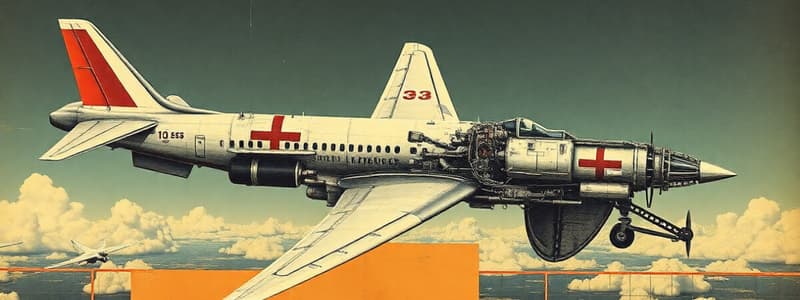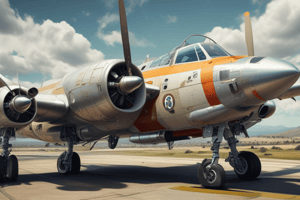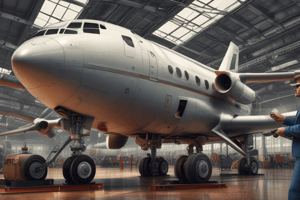Podcast
Questions and Answers
What is the minimum fuel requirement in each main wing tank for adequate cooling of the hydraulic fluid during ground operations?
What is the minimum fuel requirement in each main wing tank for adequate cooling of the hydraulic fluid during ground operations?
- 1500 lbs
- 2000 lbs
- 1800 lbs
- 1675 lbs (correct)
Which condition must be met for the PTU to operate?
Which condition must be met for the PTU to operate?
- Ground operation only
- Flaps not up and System B EDP hydraulic pressure drops (correct)
- System A hydraulic pressure drops below limits
- Airborne and Flaps up
What action must be taken if pushback is required without the nose gear steering lockout pin?
What action must be taken if pushback is required without the nose gear steering lockout pin?
- Select both System A hydraulic pumps to ON
- Select either System A or B to OFF
- Select both System A hydraulic pumps to OFF (correct)
- Initiate emergency pushback procedures
What is the primary use of the Standby Hydraulic System?
What is the primary use of the Standby Hydraulic System?
Under which scenario does the Landing Gear Transfer Unit (LGTU) activate?
Under which scenario does the Landing Gear Transfer Unit (LGTU) activate?
What must occur for the Standby Hydraulic System to automatically activate?
What must occur for the Standby Hydraulic System to automatically activate?
How can the Standby Hydraulic System be manually activated?
How can the Standby Hydraulic System be manually activated?
Does the Power Transfer Unit (PTU) transfer hydraulic fluid?
Does the Power Transfer Unit (PTU) transfer hydraulic fluid?
What is the function of the Landing Gear Transfer Unit (LGTU)?
What is the function of the Landing Gear Transfer Unit (LGTU)?
If the Master Caution, FLT CONT annunciator, and STBY RUD ON lights illuminate at FL350, what does this indicate?
If the Master Caution, FLT CONT annunciator, and STBY RUD ON lights illuminate at FL350, what does this indicate?
What is the primary reason hydraulic reservoirs are pressurized?
What is the primary reason hydraulic reservoirs are pressurized?
During flight, what symptoms indicate the presence of foaming in the hydraulic system?
During flight, what symptoms indicate the presence of foaming in the hydraulic system?
Which of the following components are not powered by Hydraulic System A or B?
Which of the following components are not powered by Hydraulic System A or B?
What occurs when Hydraulic System A fails with respect to certain components?
What occurs when Hydraulic System A fails with respect to certain components?
How does the fluid volume output of Engine-Driven Pumps (EDP) compare to Electric Motor-Driven Pumps (EMDP)?
How does the fluid volume output of Engine-Driven Pumps (EDP) compare to Electric Motor-Driven Pumps (EMDP)?
What does the RF (refill) indication next to hydraulic quantity displays signify?
What does the RF (refill) indication next to hydraulic quantity displays signify?
What action should be taken upon seeing the RF (refill) during the Preliminary Preflight Procedure?
What action should be taken upon seeing the RF (refill) during the Preliminary Preflight Procedure?
What is the normal hydraulic system pressure range for operation?
What is the normal hydraulic system pressure range for operation?
What could trigger the ELEC 2 OVERHEAT light to illuminate?
What could trigger the ELEC 2 OVERHEAT light to illuminate?
Flashcards
Hydraulic Reservoir Pressure
Hydraulic Reservoir Pressure
Pressurized to ensure positive fluid flow to all hydraulic pumps.
Hydraulic Foaming Indications
Hydraulic Foaming Indications
Foaming in flight causes LOW PRESSURE lights (Blinking) for both pumps, and MASTER CAUTION and HYD lights (Momentarily).
Common Hydraulic System Components (A & B)
Common Hydraulic System Components (A & B)
Ailerons, rudder, elevators & elevator feel, and half of the flight spoilers are common to both hydraulic systems.
Unrecoverable System A Components (Loss)
Unrecoverable System A Components (Loss)
Signup and view all the flashcards
Unrecoverable System B Components (Loss)
Unrecoverable System B Components (Loss)
Signup and view all the flashcards
Standby Hydraulic System Components
Standby Hydraulic System Components
Signup and view all the flashcards
EDP vs EMDP Fluid Volume
EDP vs EMDP Fluid Volume
Signup and view all the flashcards
Hydraulic Quantity RF Display
Hydraulic Quantity RF Display
Signup and view all the flashcards
RF Display Action
RF Display Action
Signup and view all the flashcards
Normal and Maximum Hydraulic Pressure
Normal and Maximum Hydraulic Pressure
Signup and view all the flashcards
Minimum fuel for EDMP cooling
Minimum fuel for EDMP cooling
Signup and view all the flashcards
Pushback without nose gear lockout
Pushback without nose gear lockout
Signup and view all the flashcards
Power Transfer Unit (PTU) purpose
Power Transfer Unit (PTU) purpose
Signup and view all the flashcards
PTU fluid transfer
PTU fluid transfer
Signup and view all the flashcards
PTU operation conditions
PTU operation conditions
Signup and view all the flashcards
Landing Gear Transfer Unit (LGTU) purpose
Landing Gear Transfer Unit (LGTU) purpose
Signup and view all the flashcards
LGTU operation conditions
LGTU operation conditions
Signup and view all the flashcards
Standby Hydraulic System primary use
Standby Hydraulic System primary use
Signup and view all the flashcards
Standby System activation, pressure loss
Standby System activation, pressure loss
Signup and view all the flashcards
Manual Standby Hydraulic System activation
Manual Standby Hydraulic System activation
Signup and view all the flashcards
Study Notes
Hydraulic System
- Hydraulic reservoirs are pressurized to ensure positive fluid flow to all hydraulic pumps.
- Foaming in flight will result in low pressure lights blinking and a master caution/hyd warning.
- Ailerons, rudder, and elevators (half of total) are components common to both hydraulic systems A and B.
- With hydraulic system A failure, landing gear retraction and ground spoilers are unrecoverable (no redundancies).
- With hydraulic system B failure, leading edge flaps and slats retraction and autobrakes are unrecoverable (no redundancies).
- Rudder, thrust reversers, and leading edge flaps (extend only) are powered by the standby hydraulic system.
- Engine-driven pumps (EDP) provide approximately 6 times the fluid volume of electric motor-driven pumps (EMDP).
- The hydraulic quantity RF (refill) will appear when the quantity is below 76%, specifically, on the ground, with both engines shut down and after landing with flaps up during taxi.
- During preliminary preflight, a low hydraulic quantity is indicated by the RF (refill) next to A or B quantity displays.
- Appropriate action for seeing RF during preflight is to make a M300 writeup and contact maintenance control via dispatch.
- Normal hydraulic pressure is 3000 psi and maximum is 3500 psi.
- Hydraulic system failure can be caused by an electric motor-driven pump overheating or hydraulic fluid used for cooling and lubrication that overheats.
- The minimum fuel required in each main wing tank for ground operation is 1675 lbs.
- Pushing back without a nose gear steering lockout pin requires both system A hydraulic pumps to be set to OFF.
Hydraulic System Operation
- Power Transfer Unit (PTU) provides additional hydraulic fluid for autoslats and leading edge flaps when system B's engine-driven pump is inoperative.
- PTU does not transfer hydraulic fluid, instead uses system A pressure to power a hydraulic motor-driven pump which pressurizes system B hydraulic fluid.
- The LGUT operates when airborne, No. 1 engine RPM goes below a limit, and when the landing gear lever is positioned up or has not been locked.
- A standby System B hydraulic system is primarily used as a backup if system A or B pressure is lost.
- The standby hydraulic system is activated either manually or automatically when system A and/or B pressure is lost.
- Manual activation is achieved by moving the FLT CONTROL A or B switch to the STBY RUD position or the ALTERNATE FLAPS Master switch to the ARM position.
- Standby system automatically activates when airborne with wheel speed over 60 kts; flaps are extended, and hydraulic system A or B is lost.
- A Master Caution, FLT CONT announcement, and STBY RUD ON lights illuminating at FL350 indicate automatic activation of the standby system.
- The STANDBY HYD LOW QUANTITY light illuminates when the standby reservoir is approximately half empty.
- STANDBY HYD LOW PRESSURE light (amber) indicates low output pressure from the standby pump and it is armed when standby operation is selected or automatic function is activated.
- In the event of FLT CONTROL A switching to STBY RUD position, the B system controls elevators, B system for ailerons, and standby system for rudder.
- If hydraulic system A or B fails, a reverse thrust is provided by the standby hydraulic system.
Studying That Suits You
Use AI to generate personalized quizzes and flashcards to suit your learning preferences.




